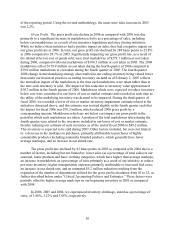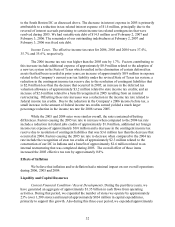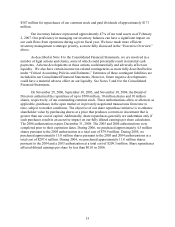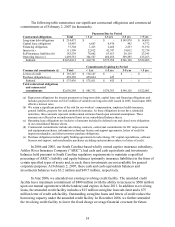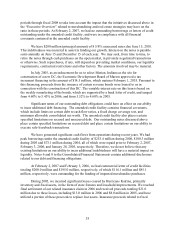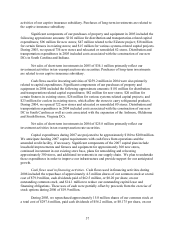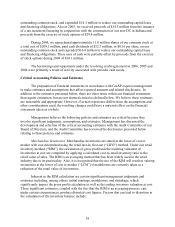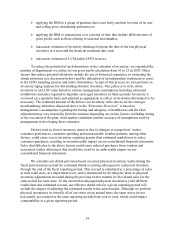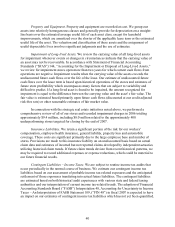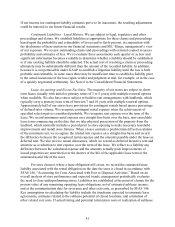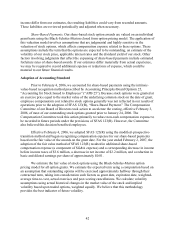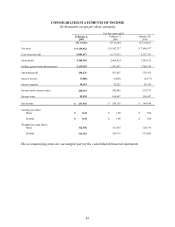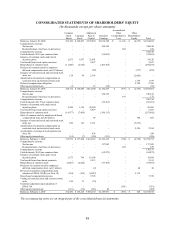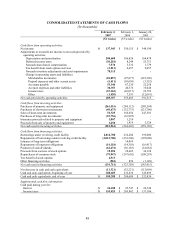Dollar General 2006 Annual Report Download - page 42
Download and view the complete annual report
Please find page 42 of the 2006 Dollar General annual report below. You can navigate through the pages in the report by either clicking on the pages listed below, or by using the keyword search tool below to find specific information within the annual report.Property and Equipment. Property and equipment are recorded at cost. We group our
assets into relatively homogeneous classes and generally provide for depreciation on a straight-
line basis over the estimated average useful life of each asset class, except for leasehold
improvements, which are amortized over the shorter of the applicable lease term or the estimated
useful life of the asset. The valuation and classification of these assets and the assignment of
useful depreciable lives involves significant judgments and the use of estimates.
Impairment of Long-lived Assets. We review the carrying value of all long-lived assets
for impairment whenever events or changes in circumstances indicate that the carrying value of
an asset may not be recoverable. In accordance with Statement of Financial Accounting
Standards (“SFAS”) 144, “Accounting for the Impairment or Disposal of Long-Lived Assets,”
we review for impairment stores open more than two years for which current cash flows from
operations are negative. Impairment results when the carrying value of the assets exceeds the
undiscounted future cash flows over the life of the lease. Our estimate of undiscounted future
cash flows over the lease term is based upon historical operations of the stores and estimates of
future store profitability which encompasses many factors that are subject to variability and
difficult to predict. If a long-lived asset is found to be impaired, the amount recognized for
impairment is equal to the difference between the carrying value and the asset’ s fair value. The
fair value is estimated based primarily upon future cash flows (discounted at our credit adjusted
risk-free rate) or other reasonable estimates of fair market value.
In connection with the strategic real estate initiatives noted above, we performed a
comprehensive review of all of our stores and recorded impairment charges in 2006 totaling
approximately $9.4 million, including $8.0 million related to the approximately 400
underperforming stores targeted for closing by the end of 2007.
Insurance Liabilities. We retain a significant portion of the risk for our workers’
compensation, employee health insurance, general liability, property loss and automobile
coverage. These costs are significant primarily due to the large employee base and number of
stores. Provisions are made to this insurance liability on an undiscounted basis based on actual
claim data and estimates of incurred but not reported claims developed by independent actuaries
utilizing historical claim trends. If future claim trends deviate from recent historical patterns, we
may be required to record additional expenses or expense reductions, which could be material to
our future financial results.
Contingent Liabilities – Income Taxes. We are subject to routine income tax audits that
occur periodically in the normal course of business. We estimate our contingent income tax
liabilities based on our assessment of probable income tax-related exposures and the anticipated
settlement of those exposures translating into actual future liabilities. The contingent liabilities
are estimated based on both historical audit experiences with various state and federal taxing
authorities and our interpretation of current income tax-related trends. The adoption of Financial
Accounting Standards Board (“FASB”) Interpretation 48, Accounting for Uncertainty in Income
Taxes – An Interpretation of FASB Statement 109, (“FIN 48”) in fiscal 2007 is expected to have
an impact on our estimates of contingent income tax liabilities which has not yet been quantified.
40


